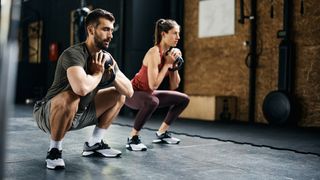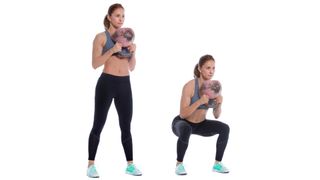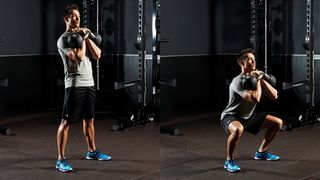How To Do The Goblet Squat
Hunker down to target your quads, glutes and hamstrings with the goblet squat

You don’t need to be the proud possessor of a goblet to pull off this effective leg exercise (sorry, LARPers), but it does require a kettlebell or dumbbell.
The move was invented by American strength and conditioning coach Dan John to help people master the correct movement pattern of the barbell back squat and gets its name from the way you cup the weight in two hands.
Whether you plan to graduate to the back squat or not, it’s a great move to include in your exercise plans, so we went to USAW Level 1-certified coach Karl Bratland for his tips and advice on how to execute the move.
Karl Bratland is a functional fitness and nutritional coach with an online fitness coaching business offering custom fitness and nutrition plans. He has a master’s degree in Exercise Science and several fitness certifications including a USA Weightlifting L1 and CrossFit Trainer.
Goblet Squat Benefits
There’s much to like about this move. For starters, the goblet squat is an important stepping stone from the unweighted squat to heavier compound lifts, such as back squats, front squats and deadlifts.
Because the load is in front of you, the goblet squat creates a natural counterbalance, making it easier to keep your torso upright and preventing your heels from rising off the floor. This in turn lowers your risk of a lower-back injury.
As with most free-weight exercises, it can be used to build strength and muscle if you use an appropriate rep scheme. But because the weight you’re lifting is limited by what you can hold in your hands (not what your legs can lift), there are better strength-boosting options out there.
It is, however, a highly effective exercise for burning fat, allowing you to do a high number of reps in one set (ideally towards the end of a weights workout) to get your heart rate high, and increase energy and oxygen consumption.
Get the Coach Newsletter
Sign up for workout ideas, training advice, reviews of the latest gear and more.
The goblet squat will improve flexibility around your hips too, and do wonders for your lower-body strength and balance.
Which muscles do goblet squats work?
The goblet squat is, first and foremost, a leg exercise. “Your lower body is used to perform the squat—the quads, glutes and hamstrings,” says Bratland.
Another muscle group that pulls its weight during goblet squats is the core.
“A goblet squat uses the core a lot,” says Bratland. “Holding the weight in front of you pulls you forward, which makes it a good functional movement because you have to really resist that force to stay upright.
“Your shoulders and arms will be used a bit to hold the weight up, but by making sure the weight is close to your body, and your elbows and hands are tucked in, you can take stress away from your arms and shoulders.”
How To Do A Goblet Squat
“Hold the dumbbell by one end as close to your chest as you can,” says Bratland. “If you hold it away from the body you won’t be able to support as much weight, so keep it close to the chest under your chin.” If you’re using a kettlebell, hold it upside down with your hands cupping the bell.
“Your feet should be a little outside shoulder-width apart, with your feet slightly turned out,” says Bratland. While Bratland encourages you to make individual adjustments by trial and error to account for your biomechanics, he recommends you avoid a narrow stance because that will make it more difficult to achieve enough depth.
Now you’re all set up correctly, it’s time to squat.

“Brace your core, push your hips back and bend your knees,” says Bratland. “Lower like you’re sitting into a chair. You don’t want to sit too far back, so pull your butt down between your legs and try to get your thighs parallel with the ground.
“Keep your chest up so you’re not leaning too far forward. Your torso might not be perfectly vertical, but leaning forward too much will put a lot of pressure on your lower back.”
Bratland is also keen to dispel the myth that your knees shouldn’t come over your toes during a squat, or any other exercise.
“If your knees are in line with your toes, it’s still a natural movement. It happens when you’re going up and down stairs or picking something up.
“It only becomes an issue when your knees start to flare out or cave in. That can create an internal pressure.”
When you reach the bottom of the rep, drive through your feet to straighten your legs and return to your starting position.
“Keep your heels flat and don’t come onto your toes,” says Bratland.
Common Form Mistakes
When trying most moves for the first time, it can be easy to fall into some simple form errors that can soon become big problems, both in terms of increased injury risk and not taxing the target muscles to the greatest extent. The goblet squat is no exception. Here are some of the most common mistakes and how to avoid them.
Falling forward
The goblet squat, like all squat variations, requires you to keep your chest up at all times to keep your center of gravity over your feet. Start by standing tall with your chest up and focus on maintaining this body position.
Falling backward
The key to avoiding this is to keep your lats—the big muscles down the rear sides of your torso—tight throughout each rep to keep your body balanced and stable. Do this by pretending someone is standing behind you trying to tickle your armpits, so you draw your elbows in towards your sides.
Wobbling
Make sure you start each rep with your abs and lower back tight and tensed. This will keep your torso more stable and assist in creating a smoother and controlled rep. Focus on squeezing and tensing your glutes at the top of each rep, too.
FAQs

Are goblet squats harder than back squats?
Bratland is keen to qualify this question before settling on an answer.
“You can make anything harder, technically, by adding more sets or reps, or changing the speed,” he says. In other words, 10 reps of goblet squats using a 100lb dumbbell is harder than one rep of a 110lb back squat, and vice versa if you swap the number of reps.
“I wouldn’t necessarily say the back squat was harder, but the two moves suit different goals,” says Bratland.
So which goals are better suited to a barbell back squat?
“The back squat is going to be better for maximal strength because you can lift more weight and develop more strength,” says Bratland. “You can still build muscle with the goblet squat, but you are limited by how much weight you can hold.
“People think the back squat is the gold standard, and it kind of is, but if you’re injuring yourself or you’re not able to use the proper form or you’re putting on too much weight, it defeats the purpose.”
How To Progress Goblet Squats
Your first option is to add weight, but there’s a limit to how much weight you can hold by your chest. If you’ve hit that limit, or the equipment you have access to is limited, here’s another way to make an exercise more challenging.
“Slow the reps down for more time under tension,” says Bratland. “Take three seconds on the way down, pause, then drive back up. Things like that will make the goblet squat more challenging, achieving more muscle activation without having to increase the weight.”
As Bratland says, pausing during the movement is a great way to increase the challenge and as well as holding the bottom of the movement you can lower in stages, pausing two or three times on the way down like a lift stopping at different floors.
To really feel the burn in your legs during your squat session, add pulses at the bottom of the movement. Push up slightly and then lower again five to 10 times, making sure to keep your back straight while pulsing. Then drive back up to the starting position.
Your final option is to change to a unilateral exercise such as the goblet split squat and work one leg at a time.
Goblet Squat Variations
Goblet squat with overhead press

If you only have time for one exercise when you hit the gym, this combo-move might well be your best bet for all-round results. Not only do you get the lower-body strength benefits of the goblet squat, but you also work your upper body by pressing the weight overhead. This enlists your shoulder and back muscles as well as increasing the challenge to your core. On top of that, if you perform long sets of this exercise or use it as part of a HIIT circuit, you’ll improve your cardiovascular fitness as well.
You can perform the move by pressing the kettlebell overhead with both hands as you come back up from your squat, or use one hand to press the weight up and switch to the other once you’ve completed half the reps in your set. This latter variation will work the muscles in your upper body unilaterally, and you’ll be able to spot if one side of your body is stronger than the other. Lifting the kettlebell one arm at a time also increases the work your core does to resist rotation and keep your torso upright.
Goblet squat with resistance band
Wrap a resistance band around your feet or shins, and move your legs apart until the band is taut before you squat. Throughout the movement you’ll have to work against the band to stop your legs collapsing in, and this strengthens the outer glutes and thighs. This in turn will help ensure your legs don’t cave in during all your future squats, even when there’s no band involved.
Double kettlebell front squat

This is a serious upgrade in difficulty on the goblet squat because you’re doubling the load, and when working with heavy kettlebells it’s actually one of the toughest types of squat you can do full stop, so make sure you have your goblet technique nailed before reaching for a second kettlebell. And while you get used to squatting with two kettlebells racked, make sure they’re light ones.
To perform the double kettlebell front squat, hold two kettlebells in the rack position in front of your shoulders. Your elbows should be close to your ribcage, with the handles of the two kettlebells held next to each other under your chin while the weights themselves rests on your forearms. Once you have both kettlebells in position, lower into a squat as normal, then drive back up.
The placement of the two kettlebells on the front and sides of the chest makes this variation especially challenging for your core, which has to battle to keep your body stable during the movement.

Harry covers news, reviews and features for Coach, Fit&Well and Live Science. With over a decade of training experience, he has tried everything from powerlifting to gymnastics, cardio to CrossFit, all in a bid to find fun ways of building a healthy, functional body.
- Joe WarnerFormer editor of Men’s Fitness UK
